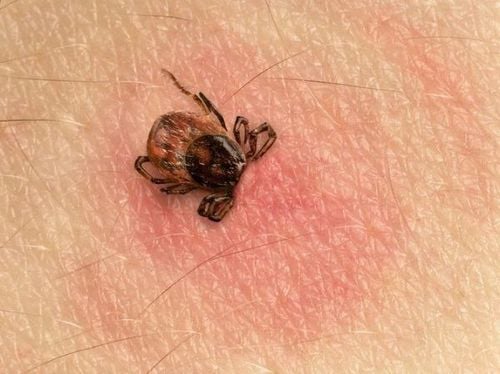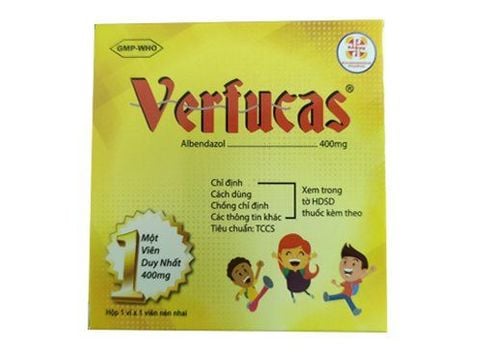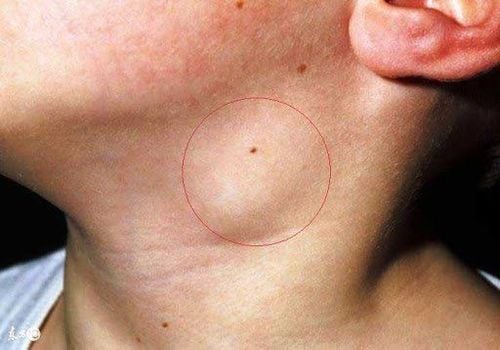This is an automatically translated article.
Scrub Typhus (English name is Scrub Typhus), also known as mite fever, is a disease caused by a bacteria called Orientia tsutsugamushi. Scarlet fever is spread to humans through the bite of a tick larva that transmits the disease-causing bacteria to humans. Symptoms are similar to other acute febrile illnesses, making it difficult to diagnose.1. Causes of scarlet fever
The pathogen is Orientia tsutsugamushi (also known as R.orientalis, or R.tsutsugamushi), obligate intracellular parasite, very dark Giemsa 2 coloration, 1.2 - 3 mm long, 0.5-0.8 mm wide. spherical or spherical bacilli, often arranged in purple-red clusters, under coated electron microscopy.R.orientalis has an incomplete yeast system that is forced to parasitize in living organisms. The antigenic structure varied, depending on the species of squirrel, rodent and geographical region. In the region, there may be many strains with different antigenic structure, so reinfection is easy to obtain and vaccine production is difficult.
There are 3 main serotypes Gilliam, Karp and Kato, which cross-react with antigens of other strains; in addition more than 30 other serotypes have been identified globally; In addition to specific antigens, R.orientalis also has non-specific antigens like the OXK antigen of Proteus mirabilis. Virulence varies greatly by strain: in Japan and China, usually more severe than in Malaysia and Vietnam.
Weak resistance, easy to kill by high temperature, in the outside environment and common disinfectants, 0.1% solution of UP formaldehyde kills in a few hours, long life in freeze-dried form in cold storage - 700C. Japan also reported some atypical strains of typhus such as Shichitonetsu, R.seunetsu causing atypical diseases.
Orientia worms transmit bacteria to the next generation through eggs and through the developmental stages, maintaining the cycle of disease transmission in areas endemic for typhus. Orientia causes disease mainly in rats and other rodents. Scarlet fever is endemic in areas with low vegetation, which is the natural habitat of mite - rat populations, often in rural areas.
An infected person enters an area where the disease is naturally endemic and is bitten by the larvae infected with Orientia. The disease often appears sporadically, can be encountered all year round, peaking in the spring - summer - autumn months, which is the time of strong growth of mites.

Bệnh sốt mò lây lan sang người thông qua vết cắn của do ấu trùng mò truyền vi khuẩn gây bệnh sang người
2. Is typhus contagious?
2.1. Transmission route of the disease Scarlet fever is a disease that is transmitted to humans through insects through the larvae of tick larvae. Thus, mites are both a host and a vector of disease; People are infected when bitten by the larvae. Patients are not capable of transmitting the disease to others.2.2. Insects that transmit the disease R.orientalis mite larvae are vectors of disease; Trombiculidae belongs to the family of mites (Acariformes), arachnids (Arachnida), and arthropods (Arthropoda); baby size less than 1 mm, color from yellow to orange, also known as red; develop through 4 stages: egg larva, pupa and adult; larvae are the only developmental stage of vertebrate mites (rats and small mammals); burning time lasts an average of 48-72 hours; After burning the larvae return to the ground, mature, and reproduce the next generation; the growth cycle of mites is 2-3 months long (warm areas) and more than 8 months (cold areas); adults live an average of 15 months; Larvae that have not yet bitten animals can live for 30 days and have a very limited range of motion, so the outbreak of scabies fever is of limited nature.
2.3. Conditions of transmission to humans Mo and larvae prefer to live in cool, moist, porous soils in crevices of caves, along rivers and streams, in cool places with bushes and low trees with fruit to wait for small animals - rodents to come and go. . People can be burned in the following conditions:
Working activities in the outbreak Cultivating the fields. Soldiers going on a picnic Sit, lie down, on the grass, let the hats and hats tie the hammock to the tree...

Ngồi, nằm nghỉ, trên bãi cỏ, để mũ nón buộc võng vào gốc cây...
3. Describe how tick fever is transmitted
The vector of tick fever to humans is an ectoparasites belonging to the family Trombiculidae with the common name of ticks. The development cycle of mites goes through 4 stages: egg, larva, larva and adult. After hatching from the eggs, the larvae crawl up the grass or low trees, rotten leaves to wait for a human or animal host. When encountering a host, the worm clings to the skin of reptiles, birds, mammals, and humans that pass or stay where they live. In humans, the most common places to cling to sting are where clothing is tight against the skin, waist and ankles. The lifespan of the squirrel depends on the species and living circumstances. Under the right conditions, squirrels usually live for about 1 year.Only the tick larva parasitizes vertebrates and humans, it is usually active in the summer. The larva has a different shape from that of an adult, very small in size, about 0.15 - 0.3 mm, with 6 legs, the body is hairy and often red-orange. It is invisible to the naked eye, most people do not see its presence until the appearance of a sting on the body. The larvae usually bite people in the lower back, armpits and genitals. With each sting, the larvae pierce the proboscis into the lymphatic vessels and suck up the lymph for a few days (from 3 to 8 days). Adults and larvae do not live as parasites in humans and animals, but live freely in trees, grass, and soil.
Mosquitoes often carry the pathogen Rickettsia tsutsugamushi (also known as Rickettsia orientalis) on the body. Mosquitoes sting people and transmit disease in each wave, mites can sting many times on many hosts. Scavenging pathogens can be passed on to its next generations. When being bitten, in addition to local lesions such as dermatitis, itching, ulcers at the site of the sting; Microorganism Rickettsia tsutsugamushi on the body of the larvae enters the body through the sting and causes tick fever.
Illness usually occurs 4-10 days after being bitten. Patients often have chills, headache, fever from 38-39 degrees Celsius, sometimes up to 40.5 degrees Celsius, swollen lymph nodes near the burning site. In some patients there may be a red rash on the face, chest, abdomen, palms of the hands and feet. The disease is sometimes very severe and can develop into an epidemic. Severe disease often has complications in internal organs, nerves and damage to the eyes. In terms of epidemiological factors, the disease usually occurs in riverside and streamside areas where there are many species of wild rats and other rodents.
4. Subjects at risk of contracting typhus disease
All ages are susceptible to the disease. The disease leaves a long-lasting immunity to the same strain, but a temporary immunity to the different strain. Reinfection due to an varietal strain, if it occurs early within a few months of recovery, will result in mild illness, but if re-infection occurs after a year or more, typical disease occurs. People living in an outbreak can be infected 2-3 times, but often have mild or latent disease (no symptoms). Infection with R.orientalis induces cellular and humoral immune response: Serum containing antibodies does not kill bacteria, but prevents bacteria from binding to membranes and entering cells, this ability is homolog-specific. ; Cellular immunity has a protective role in experimental mice, caused by T lymphocytes, because infected macrophages present pathogen antigens to T lymphocytes, in addition to the production of cytokines such as TNFα; in primary infection, T-lymphocyte activation decreases in the first week and increases on recovery, IgM appears early on day 8, IgG appears on day 12; In secondary infection, T lymphocyte activation does not decrease in the first week and increases from the second week of illness, IgG appears as early as day 6, and IgM appears only in some patients around day 12. epidemic of typhus mainly works with the same strain; People who received early antibiotic treatment had a lower antibody response and more frequent relapses than late treatment. The average antibody lifetime was 51 weeks, the conversion rate of antibody titres below 1/50 was 61%; This factor together with the presence of many strains of R.orientalis in endemic areas makes the frequency of typhus infection often high in the outbreak.5. How to prevent typhus
There is currently no vaccine to prevent typhus. Reduce your risk of catching typhus by avoiding contact with people who are already infected. When traveling to areas where tick fever is common, avoid areas with a lot of vegetation as red mites and tick larvae can be found here. If working outdoorsUse an Environmental Protection Agency (EPA) registered insect repellent containing 20% to 30% DEET or other active ingredients registered for use against red mites , on skin and clothing. Always follow the manufacturer's product instructions. Do not spray the medicine on the skin. If you are using sunscreen, apply sunscreen before applying insect repellent.

Nếu đang sử dụng kem chống nắng, hãy thoa kem chống nắng trước khi thoa thuốc chống côn trùng.
Do not use insect repellent on children under 2 months of age. Dress your child in clothing that covers their arms and legs, or cover cribs, strollers, and strollers with mosquito nets. Do not apply insect repellent to your hands, eyes or mouth or to open wounds or to irritated skin. Adults: Spray insect repellent on hands and then apply to child's face. Treat clothing and gear with permethrin or purchase permethrin-treated items. Permethrin kills red mites and can be used to treat boots, clothing and camping gear. DO NOT use permethrin products directly on the skin, but only for washing clothes. If not detected and treated promptly, it can easily lead to death. Anyone living in or traveling to areas where tick fever is found can become infected.
Please dial HOTLINE for more information or register for an appointment HERE. Download MyVinmec app to make appointments faster and to manage your bookings easily.
Article referenced source: cdc.gov












